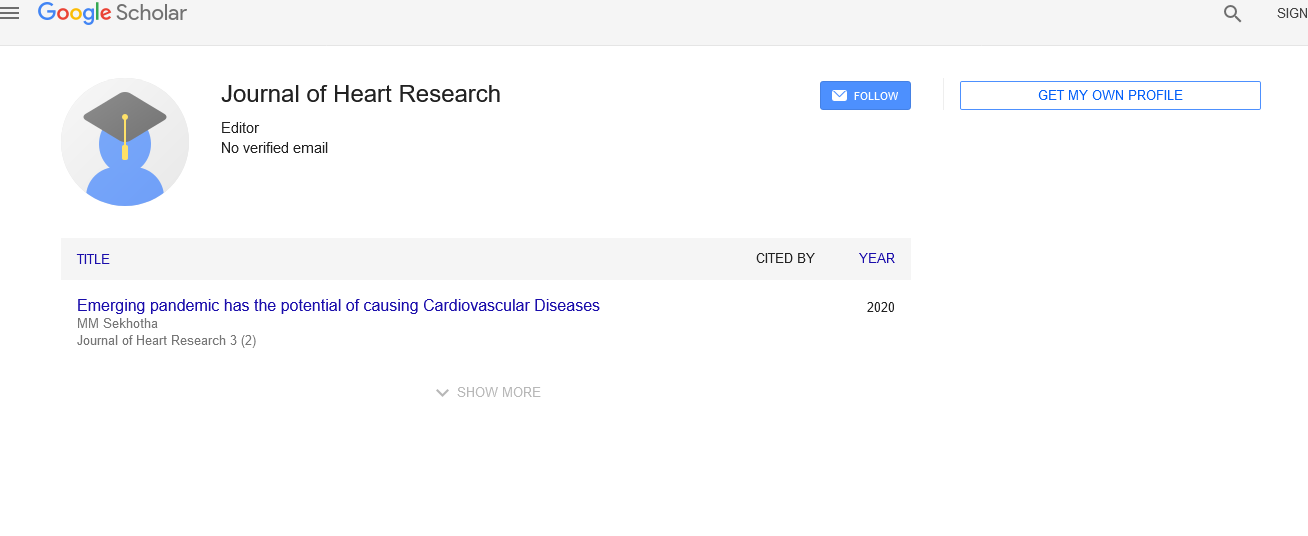Non-pharmacological treatments for angina refractory
Received: 04-Apr-2022, Manuscript No. puljhr-22-4750; Editor assigned: 07-Apr-2022, Pre QC No. puljhr-22-4750 (PQ); Accepted Date: Apr 07, 2022; Reviewed: 13-Apr-2022 QC No. puljhr-22-4750 (Q); Revised: 18-Apr-2022, Manuscript No. puljhr-22-4750 (R); Published: 29-Apr-2022, DOI: 10.37532/puljhr.22.5(2).13-14
Citation: Gladwin N. Non-pharmacological treatments for angina refractory. J Heart Res. 2022; 5(2):13-14.
This open-access article is distributed under the terms of the Creative Commons Attribution Non-Commercial License (CC BY-NC) (http://creativecommons.org/licenses/by-nc/4.0/), which permits reuse, distribution and reproduction of the article, provided that the original work is properly cited and the reuse is restricted to noncommercial purposes. For commercial reuse, contact reprints@pulsus.com
Abstract
Intractable coronary chest pain despite routine medical care and revascularization is referred to as Refractory Angina (RA). Symptoms are linked to a high rate of morbidity and a Poor Quality Of Life (QoL). For the difficult care of these cohorts, a variety of interventional pain management approaches can be considered. The proposed processes and evidence base for therapeutic techniques such Cognitive Behavioral Therapy (CBT), cardiac rehabilitation, Stellate Ganglion Blockade (SGB), Enhanced External Counter Pulsation (EECP), and Coronary Sinus Reducer (CSR) implantation are examined in this review. The use of these modalities is contingent on local availability, but suitability is best determined by expert RA services employing a multidisciplinary, individualized approach.
Keywords
Refractory angina; Enhanced external counter pulsation; Cardiac rehabilitation
Introduction
Refractory Angina (RA) is a chronic illness in which anginal symptoms persist despite receiving Optimal Medical Treatment (OMT) and revascularization. To meet the traditional diagnosis of this condition, vascular insufficiency in the context of Coronary Artery Disease (CAD) must be demonstrated, and reversible myocardial ischemia must be clinically verified as the origin of symptoms.
Although definitive data on the prevalence of RA is lacking, there is widespread acknowledgment that it is a developing problem with severe public health implications. The debilitating intensity of the symptoms associated with RA can have a significant negative impact on Quality of Life (QoL), with sufferer’s frequently necessitating hospitalization. Furthermore, patients may develop a maladaptive psychological response to their disease, characterized by an exaggerated and deregulated assessment of their symptoms.
This frequently leads to an increase in the use of secondary care services. In 2013, a prospective study of 1200 patients found that the long-term death rate related with RA was lower than previously thought. As a result, in recent years, the focus of treatment has switched from symptom relief to better QoL. However, due to the complicated interplay between physical and psychological components in RA, accomplishing these goals might be difficult. The therapeutic options for the treatment of RA are summarized in this article, with a focus on non-pharmacological therapies utilized by specialists.
Medical Therapy and Revascularization
For individuals with RA, as for patients with stable angina, pharmacotherapy and revascularization remain the cornerstone first treatments. For the purpose of event prevention, the current European Society of Cardiology (ESC) guidelines for the therapy of stable CAD indicate that all patients be treated with low-dose aspirin and a statin. As first-line antianginal medications, vasodilating pharmaceuticals such sublingual Glyceryl Triturate (GTN) and rate-limiting agents like beta-blockers or non-dihydropyridine calcium channel blockers should be administered. Additional vasodilators, such as long-acting nitrates or nicorandil, can be administered if symptoms continue despite these treatments. Ivabradine and ranolazine are two other new agents that are available. Ivabradine reduces the 'funny' pacemaker current at the sinoatrial node by inhibiting Hyperpolarization-Activated Cyclic Nucleotide-Gated (HCN) channels.
Cognitive Behavioral Therapy
Because of the psychological impact of RA on patients, Cognitive-Behavioral Therapy (CBT) is frequently utilized to assist patients better manage their symptoms. It is mainly provided by clinical nurse specialists and clinical psychologists, and the goal of the sessions is to assist patients in developing more effective coping techniques, largely through a better understanding of what angina is and addressing common misconceptions. Patients are taught that care entails more than just medication and revascularization; it also necessitates a fundamental shift in thinking processes related to symptom assessment and interpretation. The importance of making lifestyle changes, such as setting realistic goals, relaxing exercises, conserving energy, and improving sleep quality, is highlighted.
Cardiac Rehabilitation
In the setting of ischemic heart disease, rehabilitation measures lower psychological symptom burden, particularly anxiety and sadness. They're also made to improve aerobic conditioning and functional capacity. However, its role in RA has received less attention, which could be because to worries about adverse events in individuals who are already at high risk.
A pilot trial found that a 2-month outpatient rehabilitation programme enhanced exercise tolerance without causing anginal symptoms to worsen (albeit they did not improve). The study's design was poor, and it was underpowered. As a result, more research is needed before it can be considered for implementation in clinical practice, and the notion is currently unaddressed in management guidelines.
Conclusion
RA is a chronic disease that causes significant morbidity and poor quality of life. While antinational medication remains the cornerstone of treatment, it is frequently insufficient. Non-pharmacological therapies are therefore required. A number of treatments have been developed in recent decades, including pragmatic rehabilitation via CBT, pain pathway regulation by stellate ganglion blocking, and anti-ischaemic therapies like EECP and CSR implantation. Combination therapy using more than one of these techniques is becoming recognized as providing the best results. Dedicated specialist RA clinics with a multidisciplinary approach have been developed, and preliminary data suggests that such a strategy could improve RA patients' quality of life and clinical outcomes.





